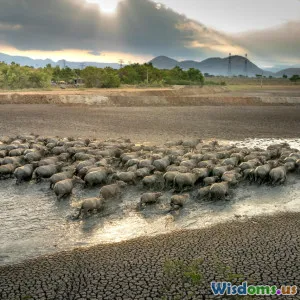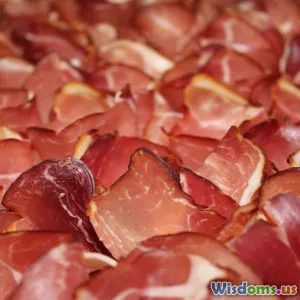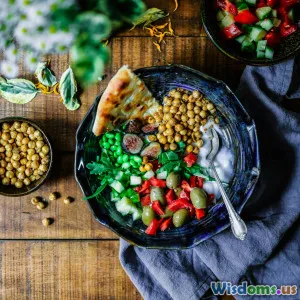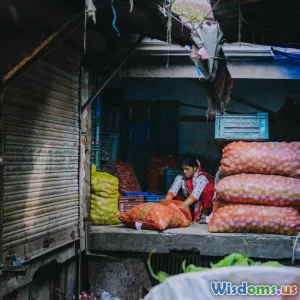
Ten Surprising Foods Helping Farmers Conserve Water in Dry Regions
9 min read Discover ten unexpected foods that help farmers save water in arid regions, transforming agriculture with innovative, drought-friendly crops. (0 Reviews)
Ten Surprising Foods Helping Farmers Conserve Water in Dry Regions
Water scarcity is one of the most pressing challenges facing agriculture today. In dry regions around the world, farmers are on the frontline, grappling with dwindling water supplies, droughts, and the growing demand for food. But what if the secret to sustainable farming in arid lands lies not just in new irrigation technology but in the very crops that farmers grow?
This article unveils ten surprising foods that are helping farmers conserve water in dry regions. By cultivating these drought-resilient and water-efficient crops, farmers are not only maintaining productivity but also securing ecosystems and livelihoods. From ancient grains rediscovered to unlikely fruits flourishing in minimal moisture, these foods are changing agricultural landscapes one drop at a time.
Why Water Conservation in Agriculture Matters
Agriculture accounts for approximately 70% of global freshwater withdrawals, most of which is lost to evaporation, inefficient irrigation, or overuse (FAO, 2021). With climate change intensifying droughts, especially in regions such as the Middle East, Sub-Saharan Africa, and parts of the western United States, farming water conservation isn't optional—it's essential.
By adopting crops that inherently require less water, farmers can reduce irrigation needs, preserve aquifers, reduce soil degradation, and build resilience in their food systems.
1. Millet – The Ancient Drought Warrior
Millet is a group of small-seeded grains traditionally grown in arid and semi-arid regions of Africa and Asia. Its resilience to poor soils and low water availability make it invaluable in dry areas.
A study in India showed that millet crops use 30-50% less water compared to rice and wheat while providing comparable nutritional benefits. Governments across Africa are promoting millet as a climate-smart crop, revitalizing diets and empowering farmers.
2. Quinoa – The Andean Pseudocereal
Native to the high-altitude Andes, quinoa thrives in dry, alkaline soils where other grains struggle. With advances in breeding, quinoa is now cultivated successfully in arid regions of the Mediterranean and Africa.
Quinoa requires roughly 250mm of water per growing season, compared to over 400mm for traditional cereals. Its rich protein profile and adaptability have caught global attention, leading to increased water-efficient production.
3. Amaranth – The Versatile Leaf and Grain Crop
Amaranth's dual-purpose leaves and grains grow quickly and tolerate drought stress well. It develops deep root systems that extract water efficiently.
In Kenya, programs promoting amaranth have helped farmers produce food during dry spells while conserving water. Its low water demand combined with high nutrient content makes it a boon for dryland farming.
4. Opuntia Cactus (Prickly Pear) – The Water-Saving Fruit
Opuntia, commonly known as prickly pear cactus, is a desert plant that requires minimal water. Beyond its ecological benefits in erosion control, its fruit and pads are valuable foods.
In Mexico and North Africa, farmers harvest prickly pear fruits and pads for human consumption and animal feed. The cactus can survive with as little as 150mm of rainfall yearly, making it an exceptional crop in dry regions.
5. Sorghum – The Heat and Drought Champion
Sorghum is one of the top drought-tolerant cereal grains worldwide. Its waxy coating reduces water loss, and it can survive in soils where other grains fail.
In parts of the US and Africa, sorghum is favored for biofuel and food production, consuming 30% less water than corn. Moreover, drought-tolerant sorghum hybrids continue to improve yields in drying landscapes.
6. Lentils – The Waterwise Legume
Legumes like lentils enrich soil nitrogen and typically use less water than other protein crops. Lentils have a deep root system that accesses subsoil moisture efficiently.
Canada, a leading lentil producer, has developed varieties thriving in semi-arid zones with as low as 350mm annual rainfall. Lentil cultivation conserves water and supports sustainable crop rotations.
7. Tepary Beans – The Desert Survivor
Native to the Sonoran Desert, tepary beans thrive in extreme heat and aridity. Their water-use efficiency often doubles that of common beans.
Farmers in southwestern US are reintroducing tepary beans as a low-water alternative, supported by tribal agricultural programs aiming to protect indigenous crops under climate stress.
8. Pomegranates – The Mediterranean Marvel
Pomegranates flourish in dry climates with limited water once established. With deep roots and thick skin, pomegranate trees minimize water loss.
In countries like Spain and Iran, pomegranate orchards require approximately 30% less irrigation water than citrus trees, yet yield highly profitable fruit crops favored worldwide.
9. Baobab – Africa’s Superfruit Tree
The baobab tree stores enormous amounts of water in its trunk to survive drought periods. Its fruit pulp, seeds, and leaves are nutrient-dense and increasingly valued in global markets.
Farmers in dry African regions are cultivating baobabs not only for traditional uses but also as sustainable income sources that demand no irrigation water.
10. Chia Seeds – The Tiny Powerhouse
Chia plants have a rapid lifecycle with low water needs. They were a staple in pre-Columbian dry regions of Central America.
Modern growers in arid parts of Australia and Mexico report up to 40% water savings growing chia compared to conventional oilseed crops, making it a promising drought-smart option.
From Knowledge to Practice: Real-World Impacts
Farmers' adoption of these water-saving foods goes beyond hydration efficiency; it aligns with socioeconomic benefits. For example, in Rajasthan, India, millet income improved farmers' livelihoods during drought years. Similarly, quinoa cooperatives in Kenya boost both nutrition and water stewardship.
Investment in seed availability, farmer education, and market development is critical to scaling these crops' potential. NGOs and governments must collaborate to create policies that incentivize crop diversification toward water-wise foods.
Conclusion: A Future Rooted in Water-Wise Foods
Conserving water in dry regions demands bold, multifaceted strategies. Adopting crops like millet, quinoa, and prickly pear cactus demonstrates how ancient knowledge meets modern challenges head-on.
Food security, ecological health, and farmer resilience are interlinked objectives achievable through embracing these surprising foods. As we rethink agriculture under climate pressures, these drought-friendly crops offer sustainable pathways, ensuring both water conservation and productive harvests.
By championing these water-efficient foods, farmers don't just save water—they seed a future of farming that truly respects nature's limits.
References:
- Food and Agriculture Organization (FAO), Water Use in Agriculture, 2021.
- International Millet Network reports, Global Drought Initiatives, 2023.
- Crop-Specific Case Studies from Kenya and India, 2022.
Author note: This article is aimed to inspire farmers, policymakers, and food enthusiasts to rethink agricultural choices to sustainably conserve water while feeding growing populations.
Rate the Post
User Reviews
Popular Posts


















